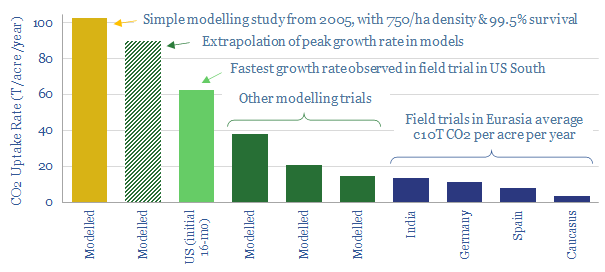The ‘Empress Tree’ has been highlighted as a miracle solution to climate change, with potential to absorb 10x more CO2 than other tree species; while its strong, light-weight timber is prized as the “aluminium of woods”. This note investigates Empress Tree CO2 uptake. There is clear room to optimise nature based solutions. But there may be risks for the Empress.
Nature based solutions to climate change represent the largest and lowest cost opportunity in the energy transition. Those who follow our research will know we see potential to offset 15-30bn tons of CO2 emissions per year via this route (summary below).
The costs are incredibly low, at $3-10/ton, when reforestation efforts are well structured through reputable tree-planting charities (note below). Hence we argue that restoring nature will push higher-cost energy technologies off the cost curve.
Broadly, our reforestation numbers assume 3bn acres could be re-planted, absorbing 5T of CO2 per acre per year, which is the average across dozens of technical papers for typical deciduous forests in the Northern hemisphere (data-file below).
There are further optimisation opportunities to capture around 10T of CO2 per acre per year using faster-growing tree species, such as poplar, eucalyptus and mangrove. However, some commentators claim that another tree genus, known as Paulownia, can achieve an incredible 103T of CO2 offsets per acre per year.
If 100T/acre/year were possible, it would be a game-changer for the potential of reforestation. It would, in principle, only require 0.2 acres of Paulownia to offset the 20Tpa CO2 emissions of the average American. For comparison, population density in the Lower 48 is around 6 acres per American.
Paulownia: the miracle tree?
What is Paulownia? Paulownia is a tree genus, named after Princess Anna Pavlovna, daughter of Tsar Paul I of Russia (1754-1801). It has at least 6 species, of which Paulownia tomentosa is the fastest-growing “miracle” variety. This species also goes by the names: Empress Tree, Princess Tree and Kiri (Japanese).
Paulownia tomentosa can grow by a remarkable 6 meters in one year and reach 27m in height. It then adds 3-4cm of diameter to its trunk each year. It is shown below towering over the other plants in a garden (here, at about 1.5 years old).
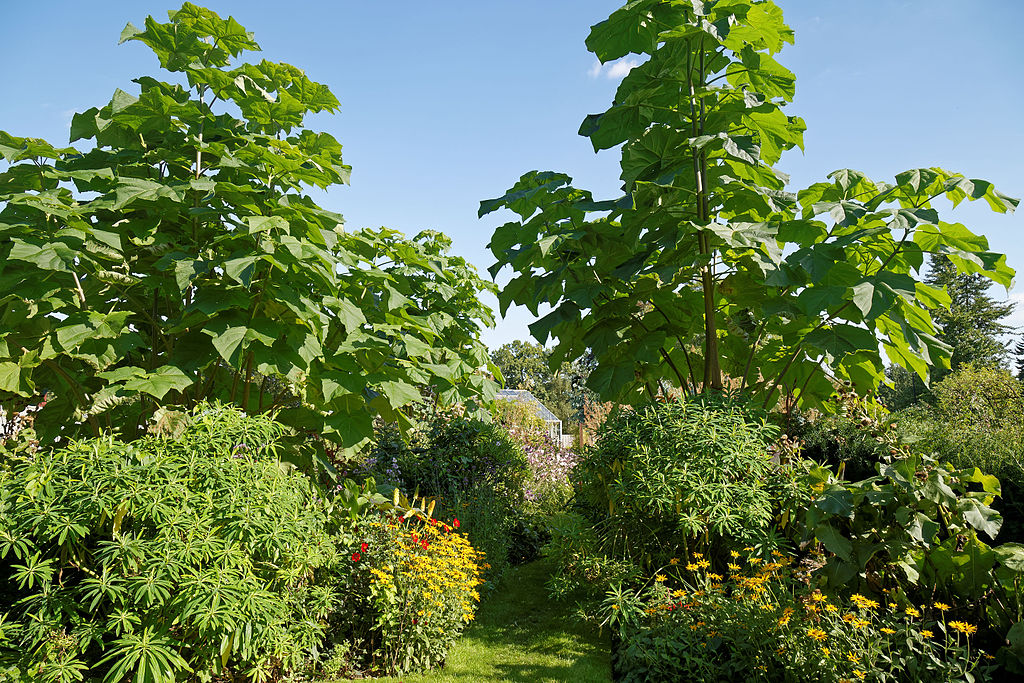
Reasons for remarkable growth rates include that Paulownia is a C4 plant. This photosynthetic pathway produces more leaf sugar, especially in warm conditions. By contrast, most other trees are C3 plants and fix CO2 using the Rubisco enzyme, which is not saturated (creating inefficiency) and not specific (so it also wastes energy fixing oxygen). Paulownia’s leaves are also very large, helping it to absorb more light. It also simply appears to have a faster metabolism than other species. And finally, its wood is 30-40% less dense than other species, allowing it to accumulate a large size quickly.
Other Advantages?
Paulownia’s timber is highly prized and sometimes termed the “aluminium of woods”. It is light, at 300kg/m3 (oak is 540kg/m3) and 30% stronger than pine. It does not warp, crack or twist. It is naturally water and fire resistant. When used in flooring, it is also less slippery and softer than other woods (which is noted as advantageous for those prone to falling over). The wood is also suited to making furniture and musical instruments.
Pollutants are well absorbed by Paulownia’s large leaves, which can be 40-60cm long. Hence one study that crossed are screens examined planting Paulownia in a Northern Italian city, to reduce particulate concentrations toward recommended limits.
Other advantages are ornamental qualities with shade, “wonderful purple scented flowers” (below), which support honey bees, and the ability to restore degraded soils.
A final remarkable feature of Paulownia is that you can cut it down and it will re-grow, up to seven times, rapidly springing back from its stump.
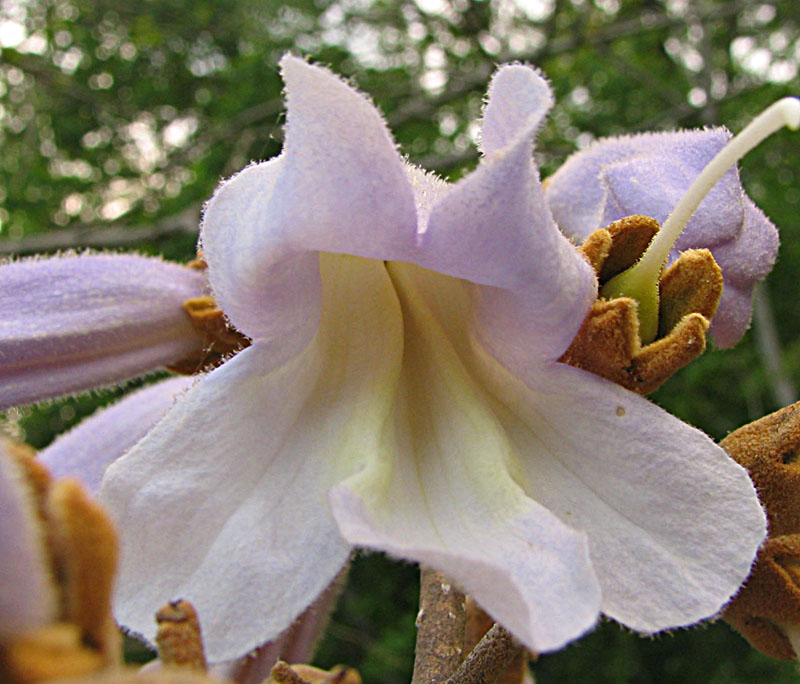
Costs of CO2 offsets using Paulownia?
Our usual model for reforestation economics is shown below, assuming a typical planting cost of $360/acre. Paulownia may be modestly more expensive to grow. Our reading suggests a broad range of $2-7/tree multiplied by c250 trees per acre in commercial plantations. The largest costs are cuttings and cultivation of saplings. Thereafter, paulownia requires “minimal management and little investment”. Hence if growth rates are 10x faster than traditional trees, all else equal, we would expect CO2 offset costs to be c10x lower, at $2-5/ton (including land acquisition costs at developed world prices).
Examples of Paulownia?
Over 2M hectares of Empress trees are cultivated in China, often being inter-cropped with wheat. But Paulownia cultivation in the Western world is more niche. As some examples: Jimmy Carter famously grows 15 acres of Paulownia trees on his farm in Georgia. As a commercial investment, WorldTree is an Arizona-based company that manages 2,600 acres of Empress Trees and plans to plant 30,000 acres more. It claims to be the largest grower of non-invasive Paulownia in the world. Furthermore, ECO2 is a privately owned Australian company, headquartered in Queensland. It claims to have cultivated a variety of Paulownia tree, which can reach 20m after 3-5 years and sequester 5-10x more CO2 than other trees, or around 2.5T of CO2 per tree. Finally, oil companies are exploring reforestation initiatives. For example, YPF noted in its 2018 sustainability report plans to test-plant 40 species of Empress Trees in 2019.
Problems with Paulownia?
Invasiveness? One of the largest pushbacks on reforestation is that large-scale planting of single forest varieties may impair biodiversity (a chart of all the pushbacks is below, with some irony that environmentalists call for drastic action to avert the perils of climate change, then often say, no, “not that drastic action”). In the US, Paulownia is categorized as an invasive plant. A single plant can produce 20M seeds in a year. In some States, such as Connecticut, sales of the plant are even banned. Paulownia did in fact exist in North America prior the last Ice Age. It was re-introduced from China in 1834, when seeds were accidentally released from dinnerware packaging materials. Whatever intuitions one might have, some factions are going to protest against Western cultivation of Paulownia.
But the greatest question mark over Paulownia’s CO2 offset credentials is in the numbers. Different studies are tabulated below.
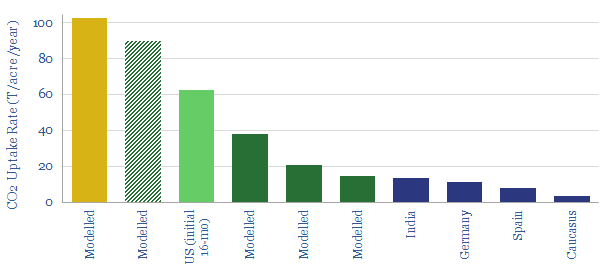
103T of Empress Tree CO2 uptake per acre is the most widely cited number online. But this figure derives from a single study, conducted in 2005. Whose methodology is woefully rough. The study simply assumes a 12’x12′ planting of Paulownia (750/ha, 99.5% survival) and then uses a formula to estimate the CO2 uptake from the trees’ target height and width.
A follow-up study was published in 2019, estimating 38-90T of Empress Tree CO2 uptake per acre per year. But upon review, the upper bound is extrapolating the “maximum growth rate”, which is known to be 2-3x faster than the average growth rate (charts below). The study is also vague on its modelling assumptions. It was funded by a company that commercializes Paulownia plantations. Finally, the study itself notes “additional research is needed in order to quantify the carbon sequestration rates of Paulownia trees under the specific management regime employed by World Tree’s Eco-Tree Program, by continuing to collect DBH values over the 10 to 12 year harvest cycle.”
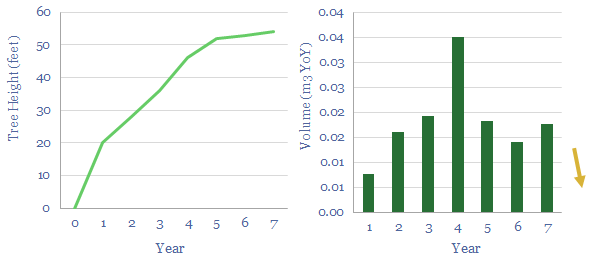
Achieving monster growth rates will vary with growing conditions. Ideal conditions are warmer climates (the tolerable range is -24 to 45C), flattish, well-drained soil with pH 5-9, <25% clay, <1% salinity, <2,000m altitude, >800mm rainfall and <28kmph wind. But past studies planting the Empress Tree in Eurasia have ranged from 3-15 tons of CO2 per acre per year, which is not so remarkable versus other tree varieties.
Diseases. Finally, dense clusters of trees may fall short of growth targets due to disease. Paulownia, in particular, is susceptible to an affliction known as ‘Witches Broom’, which causes the tips of infected branches to die, leading to a cluster of dead branches. The wood is of poor quality and the growth rate of the plant diminished.
We conclude that there is great potential for nature based solutions, especially for their optimisation to boost CO2 uptake rates. Paulownia may be among the options. However, more data may be needed in the West before it can be heralded as a miracle plant.
Our key points on Empress Tree CO2 uptake are highlighted in the research note sent out to our distribution list.
